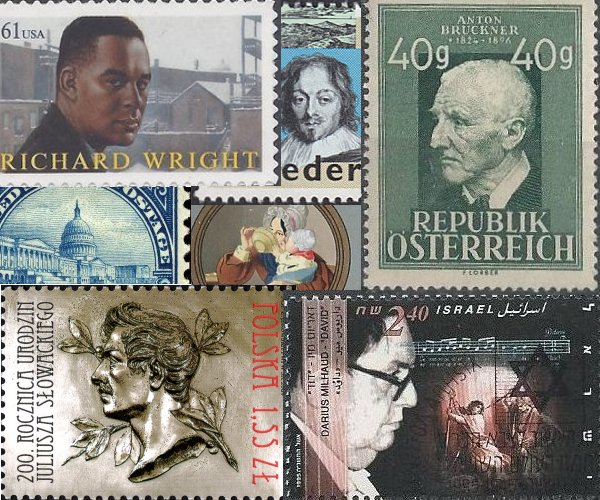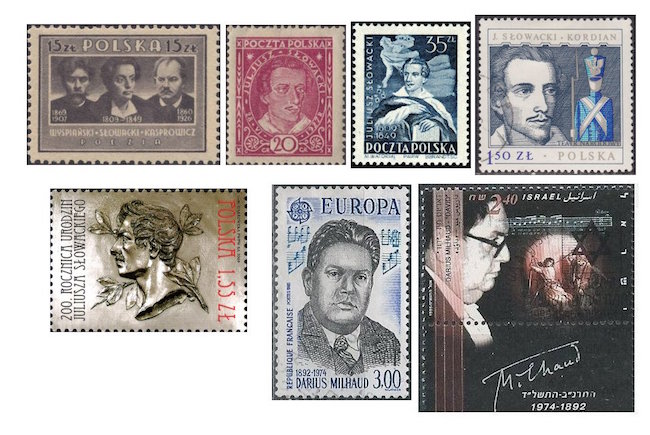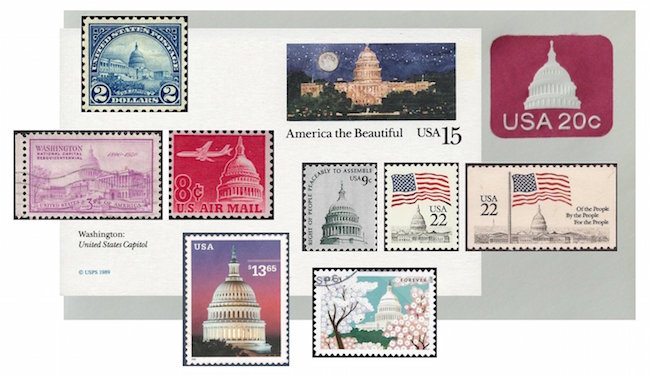The Arts on Stamps of the World — September 4
An Arts Fuse regular feature: the arts on stamps of the world.

By Doug Briscoe
Today’s birthday honorees include Richard Wright and Anton Bruckner in the gold circle, with Polish poet Juliusz Słowacki and French composer Darius Milhaud in the silver, and two very important American architects in the bronze. We also have a worthy field of honorable mentions.
Author of Native Son (1940) and Black Boy (1945), two of the seminal works of African-American literature, Richard Wright (September 4, 1908 – November 28, 1960) was born in Mississippi and grew up there and in Arkansas and Missouri, going on his own at 17 to Memphis and from there to Chicago. He had already demonstrated his gifts as a writer. He completed his first novel, Cesspool, in 1935, but this was not published until after his death. In 1937 he relocated to New York and had there his first success with the collection Uncle Tom’s Children (1938). Native Son, which Wright started soon afterward, became the first novel by an African-American to be selected by the Book of the Month Club. Orson Welles directed Wright’s stage version in 1941. Disgusted with racism, however, Wright moved to Europe and became a French citizen in 1947, there befriending Sartre, Camus, and James Baldwin, though they later had a falling out. Three years later, Wright, then 42, agreed to portray his teenaged antihero Bigger Thomas in an Argentine movie of Native Son. Toward the end of his life, Wright became fascinated with the haiku form and is said to have written some 4,000 of these poems.
Anton Bruckner (1824 – 11 October 1896) is one of those composers whose reputation rests on a handful of great, big pieces: nine (actually eleven) symphonies, three (actually five, if one includes the early Requiem) masses, a Te Deum, and a string quintet. The other pieces, motets, short organ works, some piano pieces and songs, etc., are trotted out just to let people know what “other” Bruckner there is. He was among the composers featured in the world’s first set of composer stamps (Austria, 1922—it’s the one at upper center, next to Richard Wright). Three more Austrian Bruckner stamps appeared in 1948, 1974, and 1996. The last of these shows the organ in the basilica of St. Florian in Upper Austria, the so-called Bruckner Organ, built actually long before his birth, but one at which he regularly played and under which his remains are buried. The German Stamp is also from 1996, the centenary of the composer’s death.

Collage No. 2 is reserved for the silver circle. Polish poet and dramatist Juliusz Słowacki (swo-VAHT-ski; 4 September 1809 – 3 April 1849) holds a special place in the hearts of his countrymen as one of the “Three Bards” (along with Adam Mickiewicz and Zygmunt Krasiński) of Polish literature. Słowacki came of a distinguished noble family of intellectual stature—his father was a university professor, and his mother held a literary salon where the 13-year-old boy met the great Mickiewicz (though the pair would later become antagonistic). Słowacki worked in a government post and wrote and published his first novel, Hugo, in 1830. That was also the year of the Polish Uprising against Russian rule, which the young man joined in spirit and with his pen, as well as by working for the diplomatic service of the revolutionary government in France. 1832 saw the publication of his first poetry collections and his first two dramas. He lived in Switzerland from 1833 to 1836 and wrote there one of his most admired works, the political drama Kordian (1834). In subsequent years he traveled extensively in Italy (where he met Krasiński, aforementioned Bard No. 3), Greece, Egypt, and the Middle East. He was back in Paris at the end of 1838. He became friendly with Frédéric Chopin and died in the same year as the great composer, 1849, also of tuberculosis. Słowacki’s output, 17 volumes’ worth, includes two dozen plays and over 250 poems. We see him on five Polish stamps, the most recent a 2009 bicentennial issue.
On the subject of composers, France honored Darius Milhaud (1892 – 22 June 1974) with a stamp in 1985 and Israel ten years later, neither stamp being associated with a particular anniversary. As a young man Milhaud went to Brazil as the secretary of Paul Claudel and absorbed musical influences that would appear in his works of the period, including the famous Le bœuf sur le toit. Similarly, his visit to America in 1922 introduced him to jazz, another influence that can be found again and again in Milhaud’s compositions. One of the members of Les Six, Milhaud, a Jew, spent the war years in the United States, where his students included Dave Brubeck and Burt Bacharach.

As mentioned above, we have today two leading American architects of the 19th century. The earlier of them was Thomas Ustick Walter (September 4, 1804 – October 30, 1887), whose crowning achievement was the work he did on the U.S. Capitol building—though he was the fourth to work on the project. The original design was by William Thornton (1759–1828); modifications were subsequently made by Benjamin Latrobe and Charles Bulfinch, but it was Walter who gave us the north (Senate) and south (House) wings and the central dome that replaced the lower, more modest one. The Dome, which is constructed of cast iron, by the way, was nearly completed when Thomas Crawford’s Statue of Freedom surmounted the top on December 2, 1863. Walter also created any number of other buildings: mansions, banks, churches, prisons, and courthouses. Naturally, the Capitol Dome features on many U.S. stamps, along with at least one postal card and one preprinted envelope. The oldest stamp shown here dates from 1923 and the most recent from 2015.

The other exceptional American architect was Daniel Hudson Burnham (September 4, 1846 – June 1, 1912), a prolific builder whose legacy includes Filene’s department store, his only building for Boston (1912), Gimbels flagship store in Manhattan, and Selfridges (1909) in London. Burnham had also been Director of Works for the World’s Columbian Exposition in Chicago in 1893. (Burnham had been born in upstate New York but grew up in Chicago.) Perhaps of greatest note to our Arts Fuse readers is Chicago’s Orchestra Hall, built in 1904 and celebrated on a postal card of 1990, issued in anticipation of the Chicago Symphony Orchestra’s centennial.
The father of the very great scientist Christiaan Huygens was himself a remarkably gifted and multifaceted person. Constantijn Huygens (4 September 1596 – 28 March 1687) was a poet and composer. His own parents were a secretary of the Council of State and a niece of the Antwerp painter Joris Hoefnagel. Huygens himself would serve as secretary to two Princes of Orange and become the friend of Descartes, Rembrandt, and John Donne, some of whose poems Huygens translated into Dutch. Huygens was something of a child prodigy, becoming so adept at playing the lute that his performances were much in demand, even when he was only 11 years old. He was multilingual, conversant with French, Latin, Greek, Italian, German, and English, and he wrote hundreds of poems and musical pieces. English King James I and French King Louis XIII both knighted him. Besides the great astronomer Christiaan, Huygens had another son, Constantijn Huygens Jr., who was also a poet, chronicler, a maker of scientific instruments, and an amateur draftsman of landscapes.

Austrian court painter Peter Fendi (4 September 1796 – 28 August 1842), born in Vienna, suffered an accident as an infant that left his spine permanently damaged. But it was also in childhood that his artistic talents manifested themselves. At 13 he attended an academy and at 22 was working for the Imperial Gallery of Coins and Antiquities, where he engraved a series of Austrian banknotes in 1841. As a painter Fendi worked in oils and watercolors; he also executed prints and lithographs along with the occasional wood carving. The bicentennial Austrian stamp shows his Mother with Child.
2015 marked the bicentenary of Hungarian composer Mihály Mosonyi (1815 – 31 October 1870), who was born Michael Brand and changed his name to honor his birthplace. He wrote mostly music for the piano, including a Piano Concerto in E minor (1844), but also produced two symphonies, five masses, three operas, and seven string quartets.
The composer and conductor Ján Levoslav (or Johann Leopold)Bella (4 September 1843 – 25 May 1936) was born in what today is Slovakia. He went to Vienna to attend university and earn his degree. He became a priest in 1866 but converted to Protestantism in 1881, in the meantime serving as music director for the town of Kremnica. For forty years after that he held the same post in what is now Sibiu in Romania. Bella wrote music in various genres, including, it seems, an opera set to an otherwise unused libretto by Wagner! I understand his complete chamber and organ works have been recorded.
German tenor Rudolf Schock (4 September 1915 – 13 November 1986) is shown as Don José in one of the Austrian stamps issued to commemorate the centenary of the Vienna State Opera. (The Carmen is Jean Madeira, whose birthday falls in November.) He was one of the first German singers to appear at Covent Garden after the war. He appeared in many films and sold over three million records.
A graduate of the University of Massachusetts with a B.A. in English, Doug Briscoe worked in Boston classical music radio, at WCRB, WGBH, and WBUR, for about 25 years, beginning in 1977. He has the curious distinction of having succeeded Robert J. Lurtsema twice, first as host of WGBH’s weekday morning classical music program in 1993, then as host of the weekend program when Robert J.’s health failed in 2000. Doug also wrote liner notes for several of the late Gunther Schuller’s GM Recordings releases as well as program notes for the Boston Classical Orchestra. For the past few years he’s been posting a Facebook “blog” of classical music on stamps of the world, which has now been expanded to encompass all the arts for The Arts Fuse.
